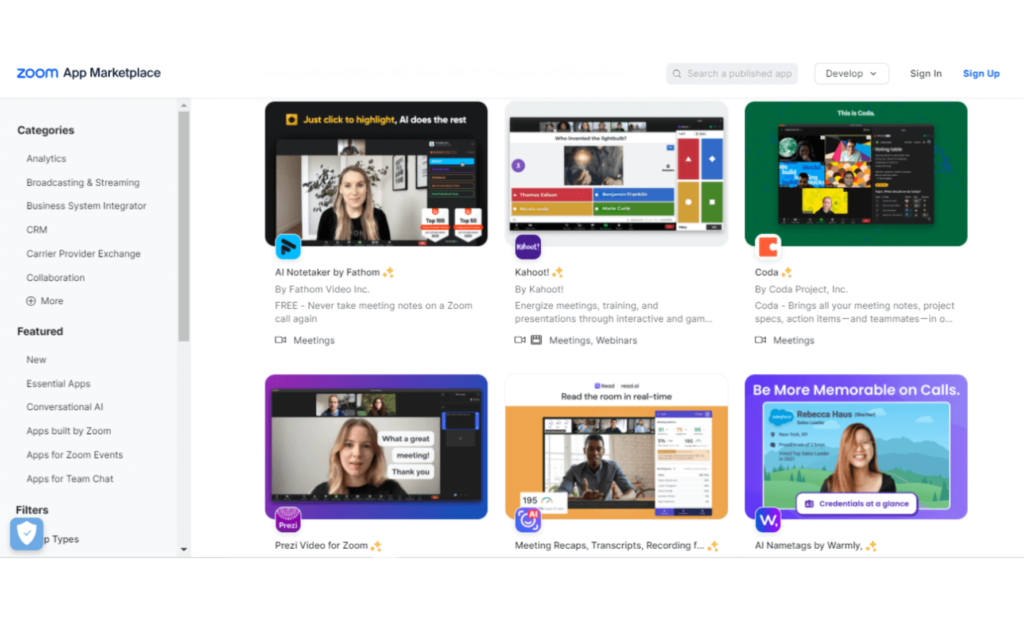
Table of Contents
ToggleIn the modern age where remote-hybrid work cultures are becoming more common, video conferencing tools have made it simple to keep in touch with colleagues. Both technologies allow distant workers to hold face-to-face conversations, whether through virtual meetings or compelling presentations.
Zoom is a superb video conferencing platform with sophisticated capabilities like breakout rooms, live captioning, and screen sharing, whereas Microsoft Teams is an excellent all-arounder that integrates meetings, calls, chats, and file sharing with the Microsoft 365 environment. But which video conferencing tool is best for your company needs?
What is Microsoft Teams?
Microsoft Teams is a video communication tool that integrates smoothly with the Office 365 suite. Teams allows distant workers to communicate digitally, the platform also includes chat and phone calling capability.

Teams may have virtual meetings with up to 300 attendees and webinars with up to 1000 participants. It connects seamlessly with other Microsoft suite products including PowerPoint, Word, and Excel. These features make it an all-in-one collaboration solution for Microsoft 365 customers.
What is Zoom?
Zoom is a cloud-based video communication programme that allows users to interact with one another online. It is popular with companies and organisations because it provides numerous basic and sophisticated capabilities that make it simple to remain connected and cooperate.
Zoom video conferencing technology has grown in popularity over the last few years. The Zoom marketplace offers apps and integrations that expand the video conferencing platform’s capabilities.

Zoom is used by both small and big businesses for daily team communication, private and group chats, and virtual meetings of up to 500 people each. Zoom’s free-forever plan offers a 40-minute session with 100 participants.
Microsoft Teams vs. Zoom
| Parameters | Microsoft Teams | Zoom |
|---|---|---|
| Price | Free Plan: $0 Microsoft Teams Essentials: $9.22/month Business Basic: $13.21/month Business Standard: $33.81/month | Zoom Basic: Free Pro: $14.99/month Business: $19.99/month Custom Business Plus and Enterprise Plans |
| Participants Limits | Free Plan: up to 100 participants Paid Plans: up to 300 participants | Free and Pro Plans: up to 100 participants Business and Business Plus Plan: up to 300 participants |
| Meeting Time Limit | Free Plan: 60 minutes Paid Plans: 30 hours | Free Plan: 40 minutes Paid Plans: 30 hours |
| Supported Platforms | Android, iOS, Windows, Linux, and Mac. | Android, iOS, Windows, Linux, and Mac. |
| Security | – End-to-end encryption – Rights Management Services support. – Secure Real-time Transfer Protocol technology | – 256-bit TLS encryption – AES-256 encryption – Optional end-to-end encryption. |
| Conferencing Features | – Application, desktop, file, and screen sharing. – GIFs and stickers – Integration with Microsoft 365 apps and services | – Application, desktop, file, and screen sharing. – Additional integrations available through the Zoom marketplace |
| Recording | Available only on paid plans. | Local recording is available on free and paid plans. |
| Whiteboard | Available | Available |
| Cloud Storage | Free Plan: 5 GB Paid Plans: 10 GB to 1 TB per user | Zoom Pro and Business Plan: 5 GB Business Plus Plan: 10 GB Enterprise Plan: Unlimited |
| Integrations | 700 plus | 1000 plus |
| Video Quality | HD 1080p by default | HD 1080p is available in video quality settings |
| Benefits | – Well-integrated with Office 365 stack – Better security – Affordable for large organizations | – Easy to set up and use – Supports up to 1,000 participants |
| Use Case | Large businesses searching for a video conferencing tool that integrates with other Microsoft products. | A user-friendly video conferencing solution with extensive functionality. |
Microsoft Teams vs. Zoom: Which Should You Choose?

Zoom and Microsoft Teams are powerful and feature-rich video conferencing platforms. They are virtually identical in terms of fundamental collaborative functionality, video quality, and other factors.
However, it is worth mentioning that Zoom concentrates on video conferencing, making it an excellent communication tool. Microsoft Teams combines many collaborative capabilities, making it an all-in-one productivity solution.
Teams vs. Zoom Pricing and Plans
Microsoft Teams and Zoom differ in terms of meeting time, file storage, participant capacity, and cost. Let’s go over the free and premium plans for both products briefly.

Microsoft Teams Pricing
Microsoft provides a free basic edition that allows you to organise 60-minute meetings with 100 participants. It also supports data encryption for meetings, calls, files, and chats, making it ideal for holding safe personal conferences.
Organisations searching for additional collaboration features might select Microsoft Teams Essentials, Microsoft 365 Business Basic, and Microsoft 365 Business Standard. With the premium Teams plan, you may hold 30-hour meetings for up to 300 people.
Zoom Pricing
Zoom, like Teams, provides five price tiers, ranging from free to $19.99 per month. With the free Zoom basic, you may organise a 40-minute session with 100 people.
Zoom Pro ($14.99 per month) and Zoom Business ($19.99 per month) are viable options for small enterprises. While the Zoom Pro subscription allows you to organise meetings with 100 attendees, Zoom Business has a restriction of 300 participants and a 30-hour duration limit.
Teams vs Zoom: User Interface
Microsoft Teams offers a more complicated user interface than Zoom and provides access to a wide range of collaboration functions. Zoom is easy to use, whereas Teams’ UI is heavy and complex.

Team User Interface
Microsoft strength is that they provide a wide range of features and functions in one location. However, in terms of user experience, Teams’ most major strength is also its greatest shortcoming.
Teams provides rapid access to various Microsoft programmes and services, might be intimidating for new users. However, with some training, Microsoft Teams outperforms Zoom.
Zoom User Interface
Zoom, on the other hand, is well-known for its user-friendliness. You only need a Zoom account to host and arrange meetings.
The contemporary video conferencing platform now includes a powerful and feature-rich Android and iOS mobile app for hosting sessions on the move.
In the fight of Teams vs. Zoom, Zoom triumphs because to its ease of setup and usability.
Teams vs Zoom: Security and Support
Security and support are two essential elements to consider while picking between Microsoft Teams and Zoom. While both include a range of security features, they differ in certain ways.
Team Security and Support
Microsoft Teams is well-known for its security features, which include end-to-end encryption, at-rest and in-transit encryption, multi-factor authentication, and more. Additionally, Teams is FERPA, SOC, GDPR, HIPAA, and FedRAMP compliant.
If you are utilising the free Microsoft Teams subscription, you may get assistance via its online help centre. Paid customers may get 24/7 assistance by chat, email, and phone (6 a.m. to 6 p.m. PT).
Zoom Security & Support
Zoom was criticised for Zoombombing after various security vulnerabilities occurred in 2020. Since then, video conferencing software has concentrated on implementing strong security mechanisms.
Zoom encrypts its platform with AES-256 encryption, 256-bit TLS encryption, and optional end-to-end encryption. Zoom offers customer support through its online help centre. Paid Zoom customers can get help via live chat or email tickets.
Microsoft Teams vs. Zoom Integrations
Teams provide a variety of connectors with Microsoft Office 365, allowing Microsoft customers to optimise their workflows. Zoom, on the other hand, prioritises collaboration by connecting with Slack, Trello, and other platforms.

Integrations across teams
Integrations or add-ons improve and widen the platform’s usability while also assisting end users in being more productive. All Microsoft Teams plans provide interaction with other Microsoft products such as Word, PowerPoint, and Excel.
Furthermore, commercial Teams subscriptions enable seamless collaboration with other Microsoft 365 apps and services including as Exchange, OneDrive, Outlook, and Word. Teams works with over 700 applications, including Trello, Asana, SmartSheet, and others, in addition to Microsoft programmes.
Zoom integrations
Zoom, on the other hand, provides a number of connectors that Microsoft Teams lacks. You can combine Zoom with over 1000 applications, including but not limited to Calendly, Notta, Miro, Salesforce, and others. Zoom also connects with Office 365, allowing you to put all of your Microsoft programmes into one location with ease.
Teams vs Zoom: Collaboration Features
Collaboration tools enable you to collaborate on presentations, papers, and other tasks. Let us briefly examine the collaboration offerings of Microsoft Teams and Zoom.

Team Collaboration Features:
Teams include enhanced in-meeting collaboration tools such as whiteboards. It’s similar to an all-in-one collaboration tool that uses personalised stickers to make talks more interesting.
I’ve used Microsoft Teams to hold and arrange meetings and like the collaboration capabilities. Its interface with PowerPoint Live and Excel Live enables distant workers to collaborate live on documents.
Zoom Collaboration Features:
Zoom’s whiteboard functionality enables teams to create and exchange ideas in virtual space. Zoom chat does not have complex capabilities, but it does provide basic operations such as screenshots, files, recordings, and emoticons.
Although Zoom chat supports emoji, you cannot send GIFs or stickers. Zoom’s avatar function allows users to build a bespoke representation of themselves by layering video images. Last but not least, the video conferencing software connects with programmes such as Google Docs and Google Sheets to enable smooth collaboration.
Microsoft Teams offers more advanced meeting collaboration features than Zoom. As a result, teams win this category.
Microsoft Teams vs. Zoom: The Verdict
After carefully analyzing both platforms, it’s clear that Microsoft Teams stands out as the all-in-one solution for businesses. With features like seamless integration with Office 365 and a user-friendly interface.
While Zoom leads in terms of simplicity and convenience of use, Microsoft Teams’ extensive features make it the favored choice for enterprises.
Teams provide everything you need to collaborate effectively in today’s digital landscape. So, when it comes to choosing the best video conferencing tool for your company, Microsoft Teams is preferred for your Business.





